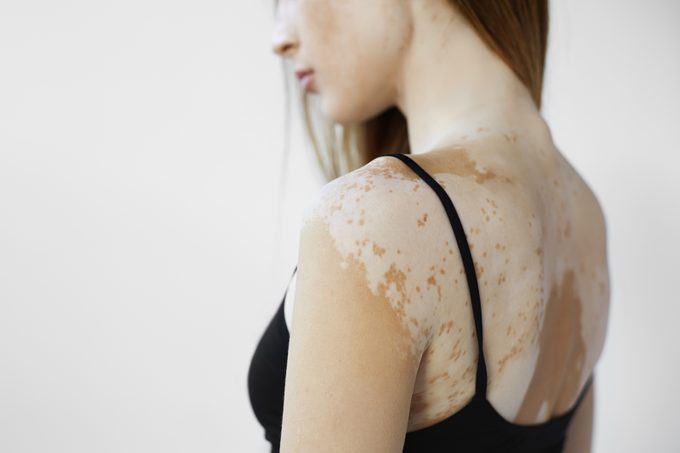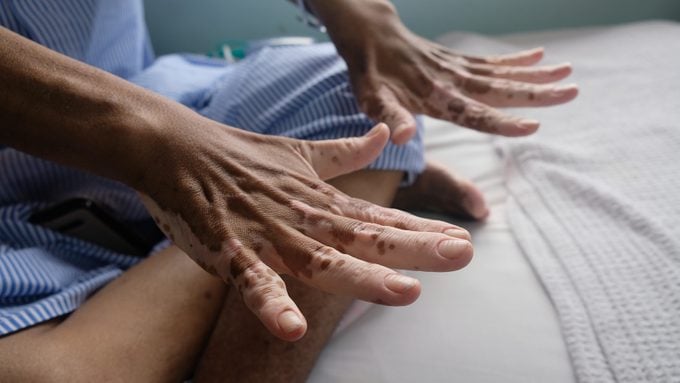
Understanding the science behind vitiligo can result in more productive discussions between people living with the condition and their doctors. The most obvious symptom of vitiligo is patches of skin which lose color, but this condition is more than just cosmetic. It is an autoimmune condition that can have a profound impact on a person’s everyday life and people who have it are at greater risk for developing other autoimmune conditions.2
An Overview of Vitiligo
One of the most noticeable symptoms of vitiligo is white patches (depigmentation) on a person’s skin. This can start on any part of the body.3 Vitiligo can affect all races and genders and can develop at any age.4

What’s the Science Behind Vitiligo?

Dr. Nada Elbuluk, a board-certified dermatologist, explains, “With vitiligo, a person’s immune system reacts against the body’s melanocytes (or pigment-producing cells) — thinking they’re foreign invaders — and attacks them” which results in a loss of skin pigment. There are also many misconceptions around vitiligo. “People may mistakenly think vitiligo is contagious, but it’s absolutely not,” noted Elbuluk.
What’s It Like Living with Vitiligo?
Unfortunately, outside of the medical community, vitiligo may be perceived as a “cosmetic issue,” which could leave people with the condition feeling misunderstood and hesitant to open up about their experiences and needs. According to a recent survey of over 3,500 people living with vitiligo, it can impact a person’s daily life, emotional well-being, and career:5
- Nearly 60% (58.7%) reported diagnosed mental health conditions, including anxiety and depression (28.8% and 24.5%, respectively)
- Almost half (49%) of survey respondents agreed that vitiligo made them feel less confident and/or more self-conscious
- More than 40% (41.9%) believed they would be farther along in their careers if they did not have vitiligo
“In my experience, lack of societal awareness about the condition can cause people with vitiligo to retreat from social activities and feel isolated. This puts them at an increased risk for mental health disorders,” explains Elbuluk. “It’s critical to evaluate each individual holistically including their mental health because I know how devastating the condition can be for those affected.”
What Are Tips for Someone Managing Their Vitiligo Journey?
People experience vitiligo differently, some with ups and downs throughout their journeys, vacillating between feeling vulnerable and confident, feeling worried, and hopeful. This can be challenging, marking the importance of building a trusted relationship between dermatologists and vitiligo patients so they can work closely together to co-create a tailored management plan.
Vitiligo is a chronic and unpredictable condition, but people living with it should not lose hope. Elbuluk shares these tips for someone living with vitiligo:
- Partner with a healthcare provider whom you trust and are comfortable with managing your vitiligo.
- Be willing to share your honest feelings about living with vitiligo.
- Connect with others impacted by vitiligo, whether one-on-one or by joining local and virtual advocacy and support groups.
- Attend vitiligo conferences to connect as a community.
- Encourage your loved ones and healthcare team to engage with these resources.
Where Can I Learn More?
If you (or someone you know) has vitiligo, it may help to surround yourself with supportive family and friends. In addition to advocacy and support groups who offer terrific resources, you can find more information about vitiligo by visiting GetToKnowVitiligo.com.
Dr. Nada Elbuluk has been compensated for her time.
- Bowcock A, Fernandez-Vina M. Targeting Skin: Vitiligo and Autoimmunity. J Invest Dermatol. https://www.sciencedirect.com/science/article/pii/S0022202X1535452X. Accessed June 23, 2022.
- Sheth V, Guo Y, Qureshi A. Comorbidities associated with vitiligo: a ten-year retrospective study. Dermatology. 2013;227(4):311-315.
- Vitiligo. Mayo Clinic. Accessed February 23, 2022. https://www.mayoclinic.org/diseases-conditions/vitiligo/symptoms-causes/syc-20355912.
- National Institute of Arthritis and Musculoskeletal and Skin Diseases. Vitiligo. https://www.niams.nih.gov/health-topics/vitiligo. Accessed February 23, 2022.
- Bibeau K, Hamzavi IH, Ezzedine K, et al. Mental Health and psychosocial burden among patients living with vitiligo: findings from the global VALIANT study. Poster presented at: Maui Derm for Dermatologists. January, 2022. Grand Wailea, Maui, HI.
